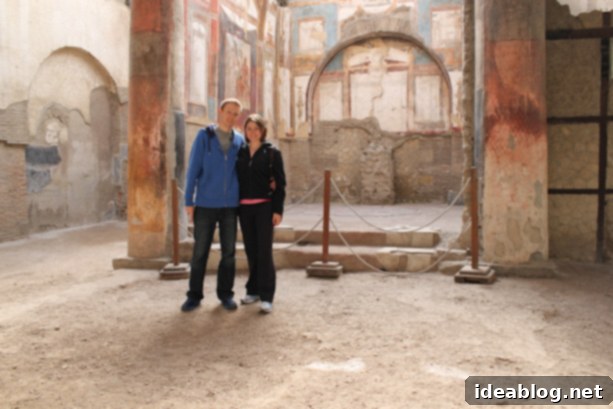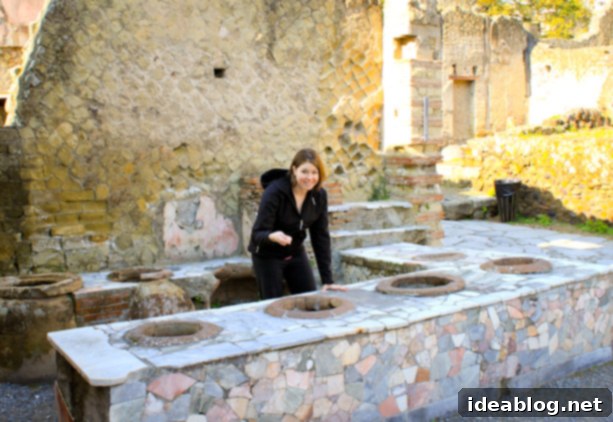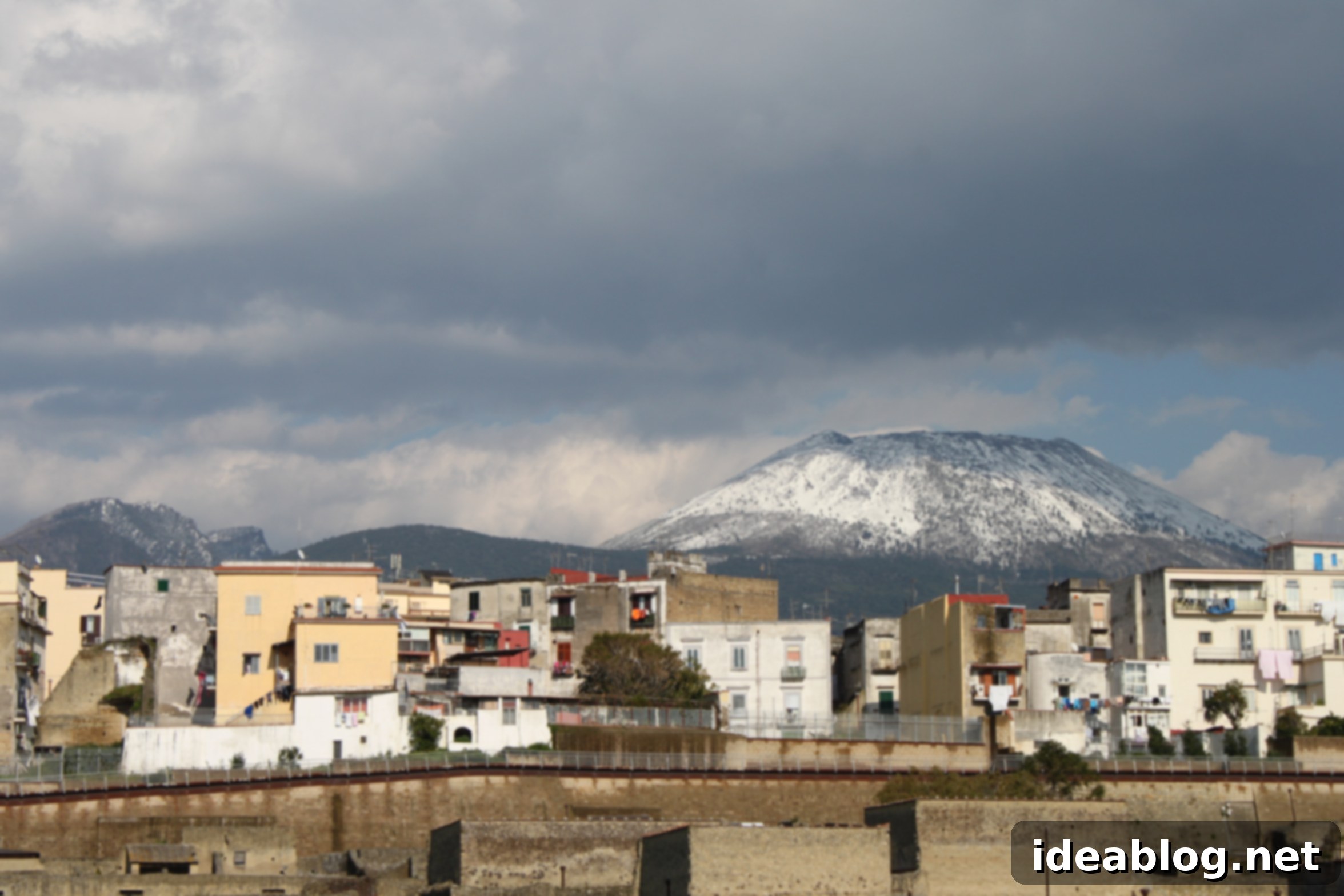Herculaneum: A Journey into the Exceptionally Preserved Roman City Buried by Vesuvius
After navigating a series of winding roads and experiencing moments of delightful confusion that brought us to the brink of giving up, we finally arrived at our highly anticipated destination: Herculaneum. The sense of achievement upon reaching this ancient site was palpable, an immediate reward for our perseverance, setting the stage for an unforgettable exploration into the past.
Prior to embarking on our Italian adventure, Herculaneum had been enthusiastically recommended by several friends and family members, all captivated by its unique allure. This archaeological marvel, dating back to 79 A.D., shares a tragic history with its more famous, and considerably larger, neighbor, Pompeii. Both ancient Roman cities met their untimely demise due to the catastrophic eruption of Mount Vesuvius. Yet, while their fates were intertwined, the manner of their destruction and subsequent preservation offers stark and fascinating differences that make Herculaneum a truly distinct and compelling site to visit, offering an intimate window into ancient Roman life.
The archaeological park of Herculaneum is beautifully situated on the outskirts of modern-day Ercolano, providing a dramatic backdrop. From within the ancient city, visitors are afforded breathtaking views of the imposing Mount Vesuvius in the distance. To our genuine surprise, the summit of Vesuvius was dusted with a pristine layer of snow, adding an unexpected, ethereal quality to the ancient ruins and highlighting the mountain’s enduring and sometimes volatile presence over the region.
Herculaneum vs. Pompeii: A Unique Preservation Story
One of the most striking aspects that differentiates Herculaneum from Pompeii is its exceptional state of preservation. Unlike Pompeii, which was primarily buried under a slow, heavy deluge of ash and pumice, Herculaneum was engulfed by much faster and incredibly hot pyroclastic flows. These dense, superheated currents of volcanic gas and debris, reaching temperatures of up to 500-600°C (930-1100°F), had a unique and profound carbonizing effect on organic materials, setting it apart from its more famous counterpart.
This intense heat did not simply encase or petrify objects; it transformed them. Wooden household items, intricate furniture, structural components of buildings, and even rolls of papyrus or food items were carbonized into solid charcoal, perfectly preserving their original forms and details. This remarkable process means that in Herculaneum, one can still see the charred remains of wooden doors, roof beams, beds, and even entire balconies, offering an unparalleled insight into the daily lives and craftsmanship of the ancient Romans. At Pompeii, such organic materials typically disintegrated, leaving only voids which archaeologists later filled with plaster casts.
Furthermore, Herculaneum was buried significantly deeper than Pompeii, sometimes under as much as 25 meters (80 feet) of solidified volcanic material. This immense protective layer acted as a natural seal, shielding the city from the elements for centuries and allowing many multi-story buildings to remain remarkably intact. Walking through Herculaneum, visitors are often astonished to find second and even third stories of buildings, complete with their original balconies, intricate staircases, and remarkably preserved roof structures. This vertical dimension provides a more complete and intimate understanding of ancient Roman domestic and public architecture, allowing for a truly immersive journey back in time. It’s this level of detail and structural integrity that makes Herculaneum a UNESCO World Heritage site and a jewel of archaeological discovery.
Stepping Back in Time: The Immersive Experience of Herculaneum
Despite being nearly two millennia old, it was remarkably easy to conjure vivid images of Herculaneum in its prime, bustling with daily life. The extraordinary preservation of the site contributes significantly to this immersive experience. Many delicate frescoes, vibrant murals, and intricate tile work have survived the centuries, still adorning the walls and floors of ancient homes and public buildings. These artistic treasures provide a colorful and detailed window into the aesthetic sensibilities, mythological beliefs, and daily routines of the Roman inhabitants, making the ancient world feel tangible and immediate.
While relatively smaller in scale compared to Pompeii, Herculaneum offers an unparalleled opportunity for focused exploration. Visitors are granted extensive access, able to wander through nearly every room and building on the site. This allows for a more intimate and less overwhelming visit, fostering a deeper connection with the individual structures and their compelling stories. The network of perfectly preserved streets, some still featuring their original paving stones and drainage systems, guides visitors through a meticulously planned urban layout, much as it would have been traversed by the Romans themselves. This feeling of stepping directly into the past is truly profound.
Highlights of Herculaneum: From Sacred Sites to Ancient Fast Food
Among the many fascinating structures, the “College of the Augustales” stood out as a particular favorite. This grand building served as both a shrine and a significant meeting place for the Augustales, an esteemed order of Roman priests primarily composed of freedmen who maintained the imperial cult. The well-preserved frescoes within its halls depict scenes relating to Hercules (the mythological founder of the city) and the Roman deities, offering profound insights into the religious practices, social hierarchy, and artistic prowess of Herculaneum’s community. Its architectural integrity and decorative elements speak volumes about its former importance.

Another captivating discovery was the abundance of “thermopoliums.” These establishments were, in essence, the ancient Roman equivalent of fast-food joints or snack bars, serving hot food and drinks to the populace. They were ubiquitous across the Roman world, catering to citizens who often lacked kitchen facilities in their own modest dwellings or simply sought a quick meal on the go. Embedded within their stone counters are large earthenware pots, or dolia, which would have stored and held dried foods, hot beverages, and pre-prepared meals. Imagining the daily hustle and bustle around these communal eateries truly brings the vibrant street life of Herculaneum to life, painting a picture of a society not so different from our own in its need for convenience.

Beyond these notable sites, Herculaneum boasts numerous other points of interest that enhance the visitor’s understanding of Roman life. The luxurious private residences, such as the House of the Bicentenary or the House of the Deer, showcase elaborate mosaics, marble cladding, and stunning internal courtyards, reflecting the wealth and artistic taste of their former owners. The public baths, essential components of Roman social life for hygiene, relaxation, and socialization, are also remarkably preserved, complete with their intricate heating systems (hypocausts) and separate sections for men and women, providing a comprehensive view of public amenities.
Perhaps one of the most poignant and somber areas of Herculaneum is the series of boat houses near the ancient seashore. Here, archaeologists uncovered the skeletons of hundreds of inhabitants, huddled together in a desperate, final attempt to escape the impending doom. These remains offer a chillingly direct and human connection to the tragedy of 79 A.D., telling a powerful story of the last moments of the city’s inhabitants, who sought refuge from the initial ash fall but were ultimately overcome by the subsequent, devastating pyroclastic flows. This site serves as a stark reminder of the immense power of nature and the fragility of human existence.
Making the Most of Your Visit: Practical Tips for Exploring Herculaneum
Our visit spanned approximately two hours, which allowed us to cover the main highlights and gain a profound appreciation for this extraordinary archaeological site. However, for those with a deeper interest in Roman history and archaeology, easily a half-day or more could be spent meticulously exploring every nook and cranny. Consider joining a guided tour to unlock deeper insights into the specific buildings, their functions, and the lives of the people who once inhabited them, enriching your overall experience.
When planning your visit to Herculaneum, comfortable walking shoes are highly recommended, as the exploration involves navigating ancient streets and various terrains. Bringing water, especially during warmer months, and sunscreen is also advisable, as much of the site is open to the elements. While the site provides a few amenities, planning ahead ensures a more comfortable and enjoyable experience. As a designated UNESCO World Heritage site, Herculaneum’s immense global importance is clear, underscoring the ongoing efforts put into its preservation, study, and presentation to the world.
Of course, no trip to such a historically rich location is complete without embracing a bit of lightheartedness. I couldn’t resist striking the quintessential tourist pose, a quirky snapshot to commemorate the awe-inspiring experience of walking through history. It’s a small personal tradition that adds a touch of modern joy to the ancient, solemn surroundings, blending personal memory with historical reverence.
Beyond Herculaneum: Continuing the Italian Adventure
After immersing ourselves in the ancient wonders of Herculaneum, we made our way back to the car, filled with a profound sense of wonder and a renewed appreciation for human history and resilience. Our next destination was Sorrento, the charming town that served as our initial base on the stunning Amalfi Coast. The transition from the silent, ancient streets of Herculaneum to the vibrant, bustling atmosphere of modern Italian coastal life was a striking contrast, yet equally enchanting and picturesque.
Upon settling into our hotel in Sorrento, the day’s adventures and the sheer volume of historical information we had absorbed caught up with us. We enjoyed a quick, delicious dinner in town, savoring the local flavors and reflecting on the day’s extraordinary discoveries, before gratefully retreating to bed. The day had been long, rich with insights, and profoundly memorable. Herculaneum stands not just as an archaeological site, but as a powerfully preserved testament to a bygone era, offering an intimate and unparalleled window into the lives of the ancient Romans, a visit that truly stays with you long after you leave.
For those interested in the beginning of our journey, you can read part one here…
